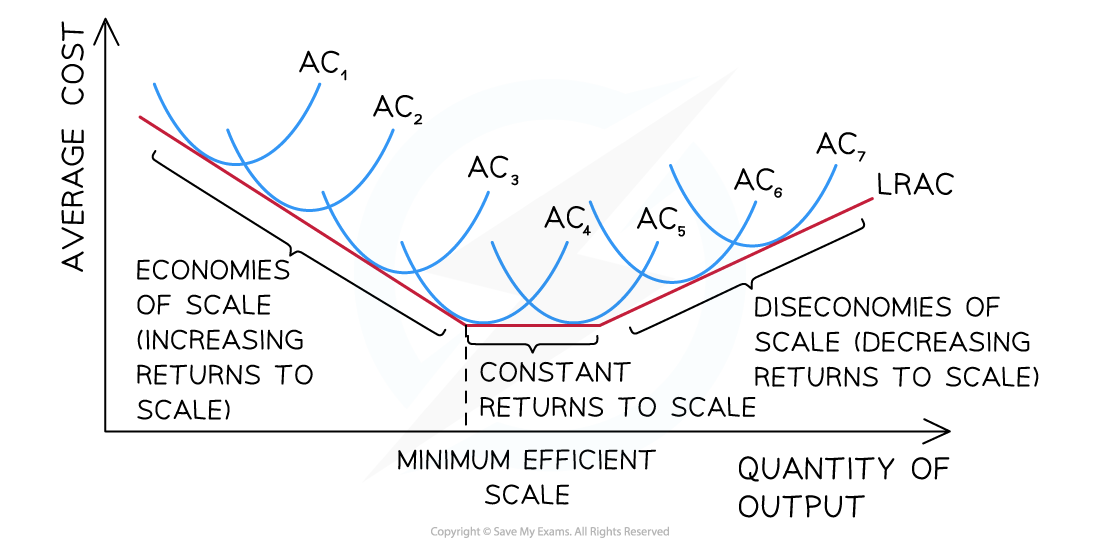- 翰林提供学术活动、国际课程、科研项目一站式留学背景提升服务!
- 400 888 0080
Edexcel A Level Economics A:复习笔记3.3.3 Economies & Diseconomies of Scale
Economies & Diseconomies of Scale
- As a firm increases its scale of output in the long-run, its long-run average total costs (LRATC) will initially decrease due to the benefits it receives
- These benefits are called economies of scale
- During this period the firm is enjoying increasing returns to scale
- These benefits are called economies of scale
- As a firm continues increasing its scale of output in the long-run, its LRATC will start to increase at some point
- The reasons for the increase in the LRATC are called diseconomies of scale
- During this period the firm is facing decreasing returns to scale
- The reasons for the increase in the LRATC are called diseconomies of scale
Types Of Economies & Diseconomies of Scale
| Economies of Scale | Diseconomies of Scale |
| Financial Economies | Management Diseconomies |
| Managerial Economies | Communication Diseconomies |
| Marketing Economies | Geographical Diseconomies |
| Purchasing Economies | Cultural Diseconomies |
| Technical Economies | |
| Risk-bearing Economies |
Minimum Efficient Scale
- The minimum efficient scale is the lowest cost point on a long-run average total cost (LRATC) curve
- It represents the lowest possible cost per unit that a firm in the industry can achieve in the long run.

As a firm grows, economies of scale help a firm to reach its minimum efficient scale before diseconomies raise the cost/unit again
Diagram analysis
- Each subsequent short-run average cost (SRAC) curve represents growth & an increase in size
- Output increases with each period of growth
- Initially firms experience increasing returns to scale as a result of the economies of scale
- At a certain level of output, the firm will reach the minimum efficient scale where it experiences constant returns to scale
- If it continues to grow beyond that level of output the firm will experience decreasing returns to scale as diseconomies of scale occur
Internal & External Economies of Scale
- All of the economies of scale explained above are internal economies of scale
- External economies of scale occur when there is an increase in the size of the industry in which the firm operates
- The firm is able to benefit from lower LRATC generated by factors outside of the firm
Sources Of External Economies Of Scale
| Source | Explanation |
| Geographic Cluster | As an industry grows, ancillary firms move closer to major manufacturers to cut costs and generate more business. This lowers the LRATC e.g. car manufacturers in Sunderland rely on the service of over 2,500 ancillary firms |
| Transport Links | Improved transport links develop around growing industries in order to help get people to work and to improve the transport logistics. This lowers the LRATC e.g. transport links around the M4 Corridor Tech Area between Reading & Bracknell have experienced significant improvement |
| Skilled Labour | An increase in skilled labour can lower the cost of skilled labour, thereby decreasing the LRATC. The larger the geographic cluster, the larger the pool of skilled labour |
| Favourable Legislation | This often generates significant reductions in LRATC as governments support certain industries in order to achieve their wider objectives e.g the animation cluster in Bristol & Bath is growing due to the tax incentives offered to the industry by the Government |
Exam Tip
Diminishing marginal returns are the reason for the shape of the short-run cost curves. Economies & diseconomies of scale are the reason for the shape of the long-run cost curves. Students often get their language confused on this theory. Increasing & decreasing returns to scale only happen in the long run. Increasing & diminishing marginal returns only happen in the short run.
转载自savemyexams

早鸟钜惠!翰林2025暑期班课上线

最新发布
© 2025. All Rights Reserved. 沪ICP备2023009024号-1








